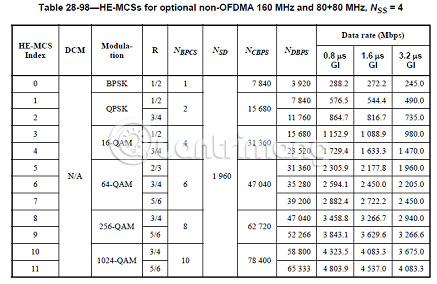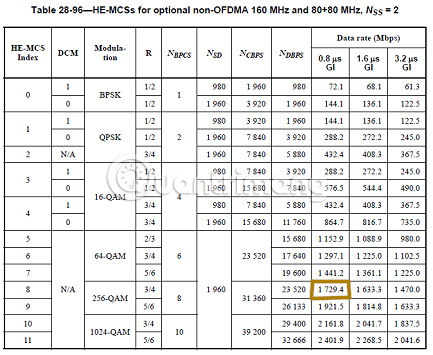5 things to know before buying a tested 11ax router
Router 11ax draft (11ax test router) has begun to appear. The first products were announced. Chip makers and finished products (end-product) are aggressively testing and fixing errors to get router products to consumers in the near future. There will be consumers willing to spend more than $ 300 (VND 6.9 million) to own one of these first 11ax routers.
This is what users should know before buying this router.
Before buying 11ax test router to note what?
- Keep in mind you are buying a product according to testing standards
- What are the technical specifications?
- No 11ax devices
- Do current devices work with 11ax?
- Has performance improved?
Keep in mind you are buying a product according to testing standards
Manufacturers often 'import' products based on this IEEE testing standard and no government agency can produce them (at least in the United States). The word "draft" - tested - does not appear anywhere on the product or information page about ASUS RT-AX88U. And if it appears on any other manufacturer's product, the word is also printed dimly, tiny somewhere on the lid of the product box or 'hidden' in a small caption on the instruction sheet. use comes.
The sale of products according to this test standard has occurred for the three most recent Wi-Fi standards (N, AC and now AX). Although products subject to this test standard will not be outdated when the latest standards are released, they do not support all the features of the officially released standard. This may be the case of 11ax.
We all know that a main AX feature, uplink MU-MIMO (uplink is the term used in computer networks, refers to connection (wired or wireless) from the local area network (LAN) to a network. Wide area (WAN)), not supported in 11ax tested products, although chipset manufacturers all say their devices can support it.
When introducing 11ac, phrases like "Wave 1" and "Wave 2" are used to make users feel that this is part of the big plan. Although there is no similar plan for the published AX standard, it is likely that this approach will be reused.
What are the technical specifications?
It took three tests, 11ax 3.0 to get through WG Letter Ballot # 233 with 86.5% approval rate last July. However, it received about 2250 comments and developers continued to resolve the outstanding issues ahead of the Draft 4.0 deadline in November. So Draft 3.0 is not yet the final test parameter. and.
Note : Draft 802.11ac 2.0 has reached an approval rate of 89%. But Draft 7.0 is still released.
No 11ax devices
As has become the norm for each standard, tested 11ax routers will be marketed before tested 11ax devices. Some tested 11ax devices will probably be announced at the CES technology exhibition, which takes place in January 2019. This time is much shorter than standard 11ac.
But the popularity will depend on the officially released standard, at least before US mobile service providers embark on this. If history is repeated, test 11ax devices are likely to appear in Asia first. And users will not see them appear in the United States until the end of 2019.
Do current devices work with 11ax?
This is an important question. Although there are certainly exceptions, most Wi-Fi devices on the market today will have better connectivity and receive a reasonable level of bandwidth from new test 11ax routers, otherwise they will soon eliminated.
Be sure that manufacturers are testing on the most popular Android and iOS devices to make sure they work well and reliably. But whether low-cost Wi-Fi switches that users have purchased on eBay work well, they need to be considered.
If past experience is correct, there will certainly be problems with compatibility issues between manufacturers. Or at least this manufacturer's specific optimization may cause problems with other manufacturers' devices. When routers based on Broadcom were first introduced to the market, their tweaks caused problems, so it was not surprising that this was repeated.
In other words, if your device is not stable with the new router, don't be too surprised.
Has performance improved?
This is a very practical question. If performance is not improved, why buy a new router?
Assuming you have a two-threaded 11ac device, common in many current smartphones, the fastest link speed will be 867Mbps in the 5GHz band and 400Mbps in the 2.4GHz band (assuming it supports 256 QAM modulation support in both 2.4 and 5GHz bands. Although 256 QAM is not standard in the 2.4GHz band, newer AC devices also support it. However, this requires the device to operate at 40MHz bandwidth mode (difficult to implement in crowded areas).
So 11ax tested how to speed things up and can it work with existing AC devices with only 160MHz bandwidth and 1024 QAM modulation? See if you can apply these things via ASUS RT-AX88U!
RT-AX88U supports four streams in both bands. ASUS assigns a maximum link speed of 1148Mbps in the 2.4GHz and 4804Mbps bands in the 5GHz band.
The maximum speed of 1148 Mbps on the 2.4GHz band requires devices that support 1024 QAM, 40MHz bandwidth and four threads, as shown in the table below (0.8uS GI column).

Because the test device has only two threads, the maximum speed is cut in half, to 574 Mbps.
But no device supports 1024 QAM in the 2.4GHz band. Therefore, the maximum speed, if the device can operate at 40MHz bandwidth or support 256 QAM, is 400Mbps, similar to any 11ac router that supports 256 QAM modulation. In summary, in the 2.4GHz band, the link speed does not increase.

For the 5GHz band, reaching 4804Mbps once again requires support of 1024 QAM, 80 + 80 bandwidth or 160MHz and four streams.
Because the test device has only two threads, the maximum speed can be halved to 2402Mbps. The only two-thread 11ac device that supports the current 160MHz bandwidth is Intel's Wireless-AC 9260. It must be stated "maximum speed is 1.73Gbps", not 2.402Gbps as calculated. This specification is not really worthy of a company like Intel.
1729.4Mbps speed only requires 256 QAM inverter (this is what AC9260 supports).

So, if connecting it to the 11ac router and providing adjacent 160MHz bandwidth (AC9260 does not specify 80 + 80 support), it is possible to double the usual maximum link speed of 867Mbps to 1733Mbps. But this was able to be achieved with adjacent 160MHz powered AC router, such as NETGEAR's R7800 Nighthawk X4S, rather than 11ax!
In summary, in the 5GHz band, the link speed does not increase unless there is Intel AC9260 and there is no adjacent 11ac router 160 MHz.
Users will hear a lot about "miracles" of 802.11ax because manufacturers consider it a huge benefit. Keep in mind that most of the common features like OFDMA Up and Downlink, Spatial Reuse with Color Codes, Resource Scheduling, MU-MIMO 8x8 and even 1024 QAM will not work until you purchase the 11ax device. experience.
Technically 11ax devices may take less time than 11ac devices if they transmit the same data, but these wonders will not appear until 11ax devices are available on the network.
Although there may be small benefits due to better RF design and faster processor, users still have to wait for compatible devices to come out to see real improvement.
See more:
- Instructions for choosing the right Wi-Fi router
- How to choose the best Wi-Fi channel for the router
- Top best 802.11ac Wi-Fi wireless router
You should read it
- Learn about mesh routers
- How to change DNS server on the most popular routers
- What's on the ASUS RT-AX88U and NETGEAR RAX80 - 2 the first Wi-Fi 6 router on the market
- Explain the rule 30-30-30 when resetting the router
- Wi-Fi 6, how will the next Wi-Fi version change the concept of wireless networks?
- What is a router? Operating principle of Router
- Learn about Wi-Fi 6
- Set up a new router using IP address 192.168.1.1
May be interested
- Explain the rule 30-30-30 when resetting the router
 technology enthusiasts have developed a so-called 30-30-30 rule when the hard reset router helps bring any router back to its original default settings.
technology enthusiasts have developed a so-called 30-30-30 rule when the hard reset router helps bring any router back to its original default settings. - Wi-Fi 6, how will the next Wi-Fi version change the concept of wireless networks?
 the next wi-fi version will be called wi-fi 6, not a technical name like 802.11ab or 802.11n.
the next wi-fi version will be called wi-fi 6, not a technical name like 802.11ab or 802.11n. - Wrong router placement makes Wi-Fi weak
 besides the router and the transmission quality, things in your house can also cause problems with your wi-fi connection.
besides the router and the transmission quality, things in your house can also cause problems with your wi-fi connection. - 7 most important things to consider before buying a Windows laptop
 to make it easier for you to determine your needs, tipsmake.com.com has compiled a list of questions you need to answer when looking for the perfect windows laptop.
to make it easier for you to determine your needs, tipsmake.com.com has compiled a list of questions you need to answer when looking for the perfect windows laptop. - Learn about Wi-Fi 6
 wi-fi 6 is the latest update to the wireless network standard. wi-fi 6 is based on the ieee 802.11ax standard, with faster speeds, larger capacity and improved power performance than its predecessor 802.11ac standard.
wi-fi 6 is the latest update to the wireless network standard. wi-fi 6 is based on the ieee 802.11ax standard, with faster speeds, larger capacity and improved power performance than its predecessor 802.11ac standard. - What is a router? Operating principle of Router
 to better understand what a router is, let's take a look at the article below with huy khang. router is a device that spreads wifi waves to connect to many devices.
to better understand what a router is, let's take a look at the article below with huy khang. router is a device that spreads wifi waves to connect to many devices. - Things to know before buying dietary supplements
 many people are unaware of the risks, limitations, and marketing gimmicks behind the labels. here's what consumers need to know before buying dietary supplements:
many people are unaware of the risks, limitations, and marketing gimmicks behind the labels. here's what consumers need to know before buying dietary supplements: - Set up a new router using IP address 192.168.1.1
 192.168.1.1 ip address is often used by linksys broadband routers and sometimes by other router brands or home network gateway devices.
192.168.1.1 ip address is often used by linksys broadband routers and sometimes by other router brands or home network gateway devices. - Qualcomm built a new Wi-Fi chip for the Wi-Fi 802-11ax generation
 qualcomm has announced a wi-fi chip for phones and tablets today compatible with the upcoming wi-fi generation.
qualcomm has announced a wi-fi chip for phones and tablets today compatible with the upcoming wi-fi generation. - Steps to check iPhone before buying
 buying new phones, especially high-end products like the iphone, is one of the top things consumers care about on issues such as quality, reputation ... the following article will help you feel secure in choosing a phone. phone as you like before buying.
buying new phones, especially high-end products like the iphone, is one of the top things consumers care about on issues such as quality, reputation ... the following article will help you feel secure in choosing a phone. phone as you like before buying.










 Learn about 5G NR router and D-Link's WiFi Exo router
Learn about 5G NR router and D-Link's WiFi Exo router What's on the ASUS RT-AX88U and NETGEAR RAX80 - 2 the first Wi-Fi 6 router on the market
What's on the ASUS RT-AX88U and NETGEAR RAX80 - 2 the first Wi-Fi 6 router on the market How does the LAN switch (LAN switch) work?
How does the LAN switch (LAN switch) work? How to secure IoT device properly
How to secure IoT device properly How to turn Raspberry Pi into travel router with VPN
How to turn Raspberry Pi into travel router with VPN Top 6 best 3G / 4G mobile WiFi transmitters
Top 6 best 3G / 4G mobile WiFi transmitters